Low FODMAP Deep-Dish Pizza is possible to create in your very own home oven. What distinguishes this style of pizza is its depth and thickness of crust, abundance of cheese, sauce and fillings, and the fact that many deep-dish pizza dough formulas contain cornmeal as well as butter. You do need a 9-inch (23 cm) deep-dish pizza pan. More information below. For general pizza info please read our articles Everything You Need To Know About Low FODMAP Pizza and Low FODMAP Pizza Ingredients & Equipment.
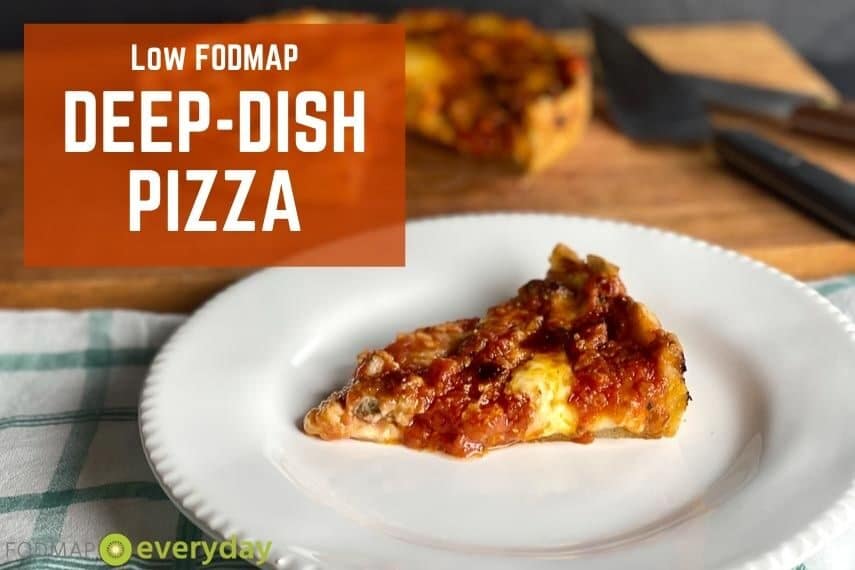
Pizza Doesn’t Equal Biscuit
This heading might strike you as odd, but if you do any amount of deep-dish pizza research you will come across descriptions of deep-dish pizza crust as “biscuit-like”. I do not know where this originated, and it is not how I would describe it.
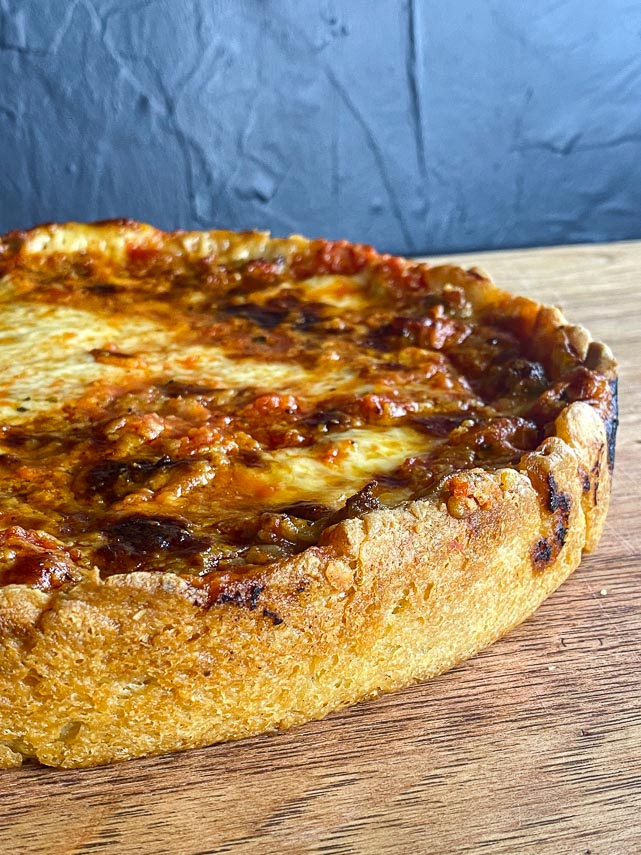
Deep-dish pizza crust is substantial and, as mentioned above, typically has the inclusion of cornmeal and butter, however, if one of my biscuits came out like this dough, I would be disappointed. Once of the key aspects of a biscuit for me is flakiness, and deep-dish pizza crust is not flaky.
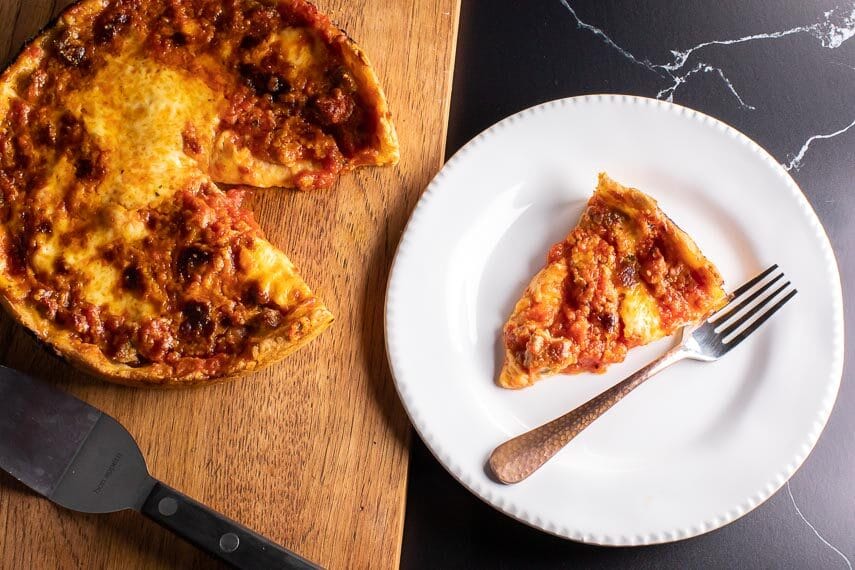
So, if you are looking for biscuit-like, this recipe is not it. If you want a hearty deep-dish pizza that happens to be low FODMAP, read on. As with all of our pizza recipes, there is affair amount of education involved but once you read it through you will be ready to go.
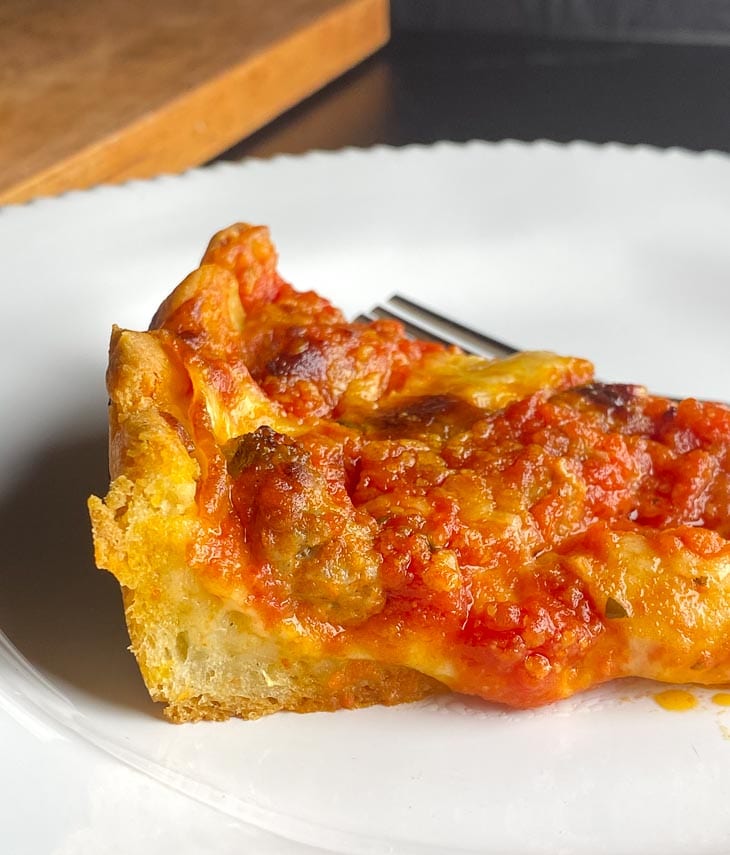
It is pizza with a deep, bready crust, that includes butter and cornmeal, and it is baked in a deep-sided round pan. Other distinguishing factors are that the cheese is under the sauce, and Italian sausage was involved in the original.
I have added butter and cornmeal as that is what was used in the original. Please make sure you use the correct cornmeal; info down below under Ingredients.
The history of deep-dish pizza is somewhat clouded. Expert culinary historians have lamented the dearth of written records, recipes or images. According to the Chicago Tribune, much of the “paper trail indicates the pizza almost certainly came out of a 19th Century mansion built with lumber money at 29 E. Ohio St. – the restaurant now known as Pizzeria Uno. But the question of who exactly developed the concept remains a mystery.”
Tim Samuelson, a culinary historian from Chicago says that he uncovered enough background to now state that he believes that the deep-dish pizza appeared in 1943, sporting its thick crust, sauce on top of the cheese and Italian sausage within.
It was made at a restaurant located in the mansion on East Ohio at Wabash, which was originally built by Chicago lumber baron, Nathan Mears. The founders of the pizzeria were Richard Novaretti, known as Ric Riccardo, and native Texan Ike Sewell, a liquor distributor.
History tells us that they originally took a stab at a Mexican restaurant, but Riccardo got food poisoning from a test meal. He suggested they try pizza and supposedly it was Ike who said they should try an oversized pizza, to be served as an appetizer. Who developed the recipe is debated. According to world pizza champion Tony Gemignani Riccardo and Sewell had a chef named Rudy Malnati who should be hailed as the originator. The initial name of the restaurant was The Pizzeria, later dubbed Pizzeria Riccardo and eventually Pizzeria Uno in 1955 (as they opened Pizzeria Due in another Mears mansion at the corners of Wabash and Ontario at the same time).
You can find alternate stories involving former employees, bartenders, managers and what have you, but the story above is the most rigorously researched and documented.
Yes, you can. I prefer using my stand mixer, but I give you both options in the recipe.
You need a deep round pan. Diameter is important. I tried 6-inch pizzas and they work, but they felt skimpy. With our low FODMAP gluten-free dough I was not a fan of those made in 10-inch (25 cm) pans or larger; they did not cook evenly and thoroughly, yielding doughy centers. I found 9-inch (23 cm) pans to be the sweet spot for diameter.
As for what the pan is made out of, there are some dos and don’ts.
Dos
● Seasoned, dark colored steel pans work very well. Note they must be seasoned before use and must be kept seasoned.
● Dark colored, heavy duty aluminum pans with nonstick coatings are highly recommended. I like Chicago Metallic.
Don’ts
● Cast-iron can work wonders, but I look at those as cast-iron pizzas, and not truer-to-form Chicago pizza.
● Light colored, lightweight aluminum pans are not preferable; crust has a tendency to stick.
First of all, you do not have to unmold the pizza. I just wanted to for a pretty picture and so that you could see the crust. After about 10 minutes of cooling, I used a very flexible spatula and inserted it along the side and underneath the pizza and quickly but carefully pried the whole thing up and out
Unmolding the pizza allowed me to show you the crispy bottom crust. Ready to take a bite?
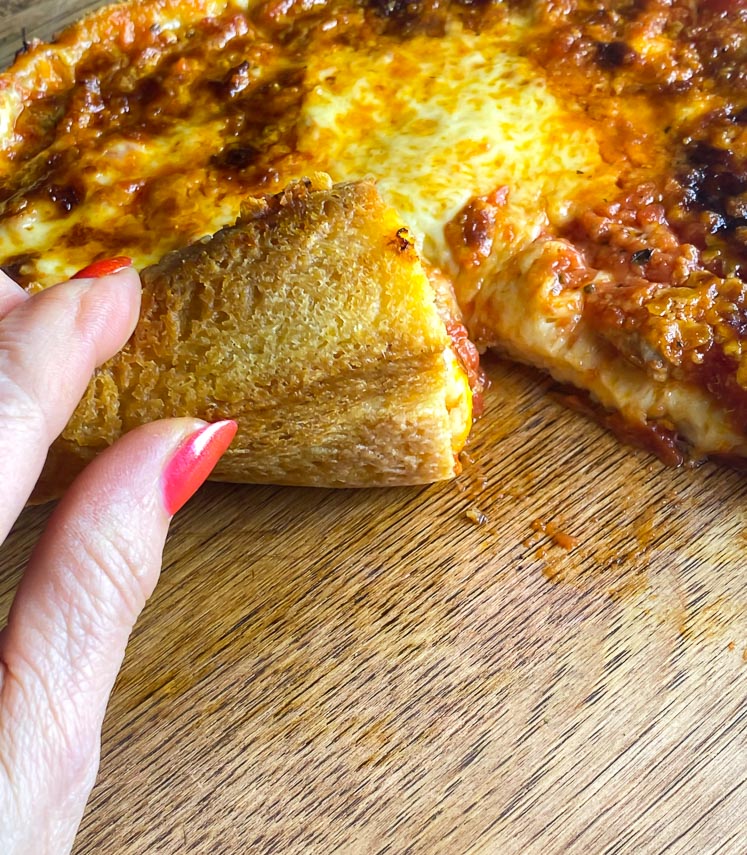
Can I Make Deep Dish Pizza Without Sausage?
You can but I have caveats. The idea behind deep-dish pizza is that it is stuffed with a lot of delicious ingredients. It is the opposite of our Low FODMAP Grilled Pizza, for instance, which is very light on toppings.
If you are going to leave the sausage out, I suggest adding something else in its place to add flavor, texture and bulk. Here are some suggestions. Please note that the FODMAP load will be different with each iteration; use your Monash app and FODMAP Friendly app to assess serving size of pizza.
- Deep-Dish Pizza With Green Peppers & Mushrooms: Heat 2 tablespoons of Low FODMAP Garlic-Infused Oil, made with olive oil, in a skillet. Sauté 8-ounces (225 g) of trimmed, chopped, oyster mushrooms until moisture largely evaporates. Add 1 thinly cored and sliced green pepper and sauté until soft. Season with salt, pepper, a little dried oregano and basil and dried red pepper flakes.
- Deep-Dish Spinach & Ricotta: Heat 1 tablespoons of Low FODMAP Garlic-Infused Oil, made with olive oil, in a skillet. Sauté 8-ounces (225 g) of baby spinach until moisture largely evaporates; cool. Combine with ½ cup (115 g) ricotta or Low FODMAP Ricotta. Season with salt, pepper, a little dried oregano and dried red pepper flakes.
- Deep-Dish Artichoke, Broccoli & Red Bell Pepper: Heat 2 tablespoons of Low FODMAP Garlic-Infused Oil, made with olive oil, in a skillet. Add 8-ounces (225 g) broccoli florets and 1 thinly cored and sliced red pepper and sauté until crisp-tender. Meanwhile drain one 375 g can of water-packed artichokes. Quarter them and pat dry; toss into sautéed vegetable mixture and season with salt, pepper, a little dried thyme and dried red pepper flakes.
- Deep-Dish Scallion, Zucchini & Eggplant: Heat 2 tablespoons of Low FODMAP Garlic-Infused Oil, made with olive oil, in a skillet. Add ½ cup (32 g) chopped scallion greens and sauté until softened. Add 1 cup (75 g) diced eggplant and 1 cup (150 g) diced zucchini and sauté until tender and beginning to brown. Season with salt, pepper, a little dried thyme and rosemary.
Ingredients
The a-typical pizza dough ingredients in this recipe are the butter and cornmeal. The butter should be unsalted, which you probably have in your fridge anyway.
The cornmeal should be medium grind. I use Bob’s Red Mill. There are huge differences between fine, medium and coarse cornmeal and they are not interchangeable. Please make sure to buy the right kind, which I show you below.
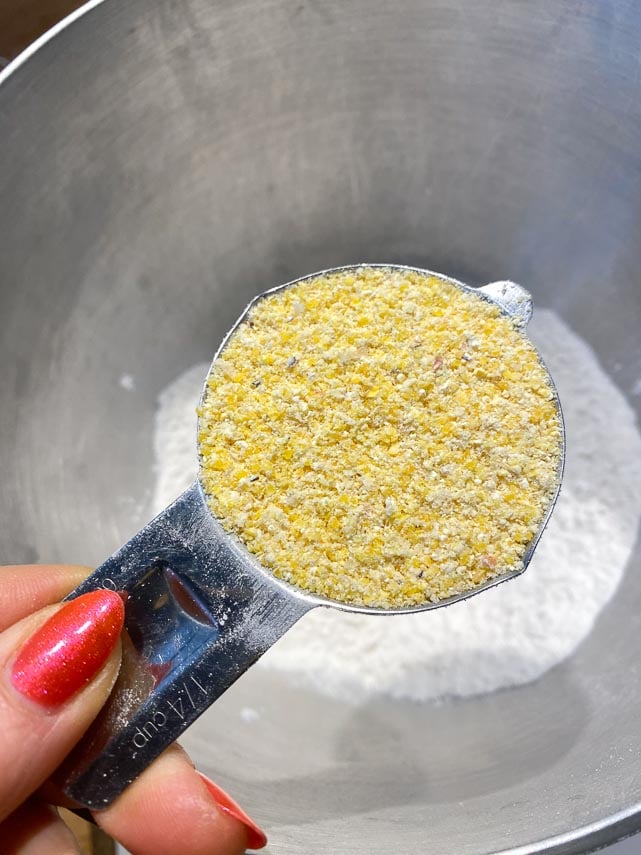
How To Make Deep-Dish Pizza
For Making By Hand: Whisk together flour, cornmeal, sugar, salt, instant yeast, and xanthan gum in a large bowl to aerate and combine. Add the warm water and 2 tablespoons melted butter and begin to stir together with a sturdy wooden spoon until a wet dough forms, then beat vigorously until mixture looks like a soft, somewhat wet batter with a little elasticity.
For Making With A Stand Mixer: Place flour, cornmeal, sugar, salt, instant yeast, and xanthan gum in stand mixer bowl fitted with flat paddle attachment.
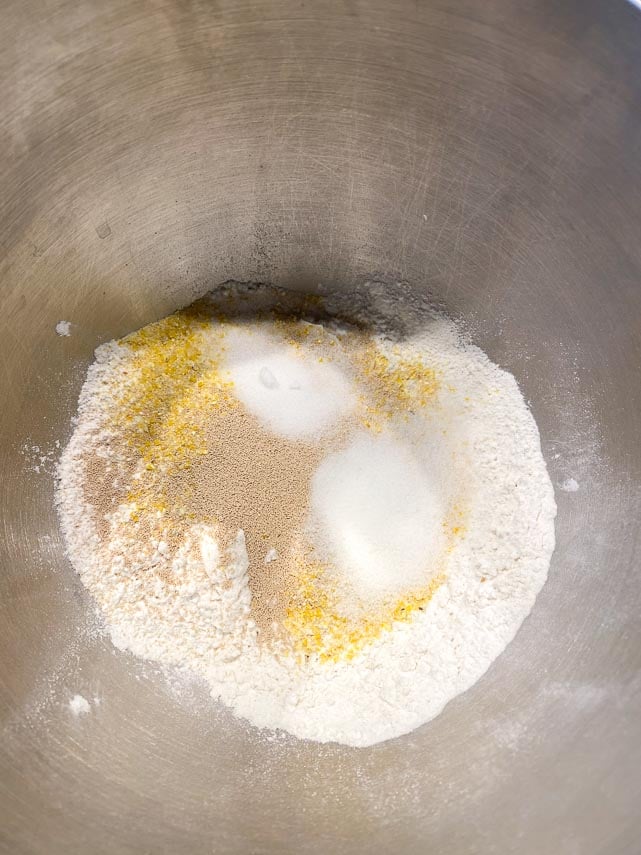
Make sure your melted butter and water areas the proper temperature.
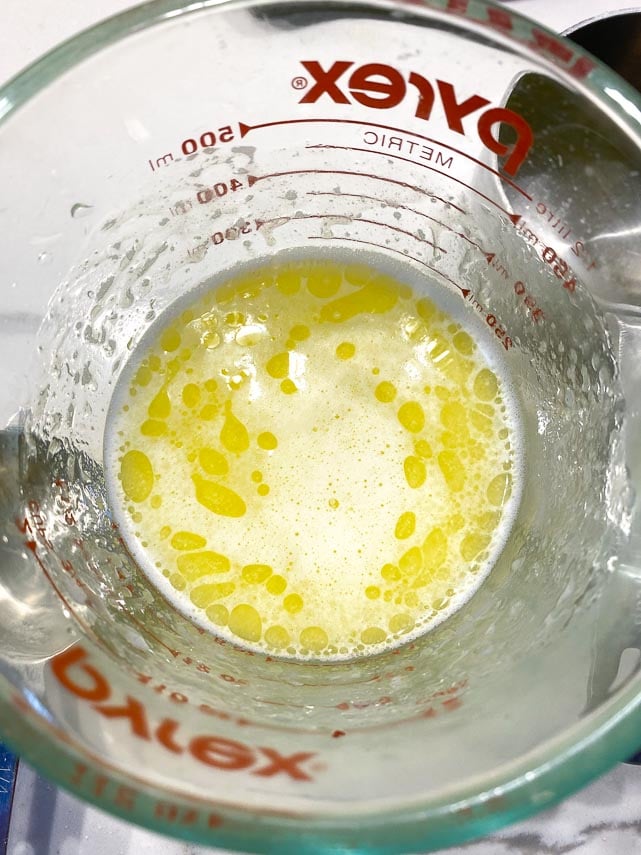
Mix on low to aerate and combine. Add the warm water and 2 tablespoons melted butter and mix on low-medium speed until a wet dough forms, then turn speed up to medium to medium-high and beat until mixture looks like a soft, somewhat moist dough with a little elasticity.
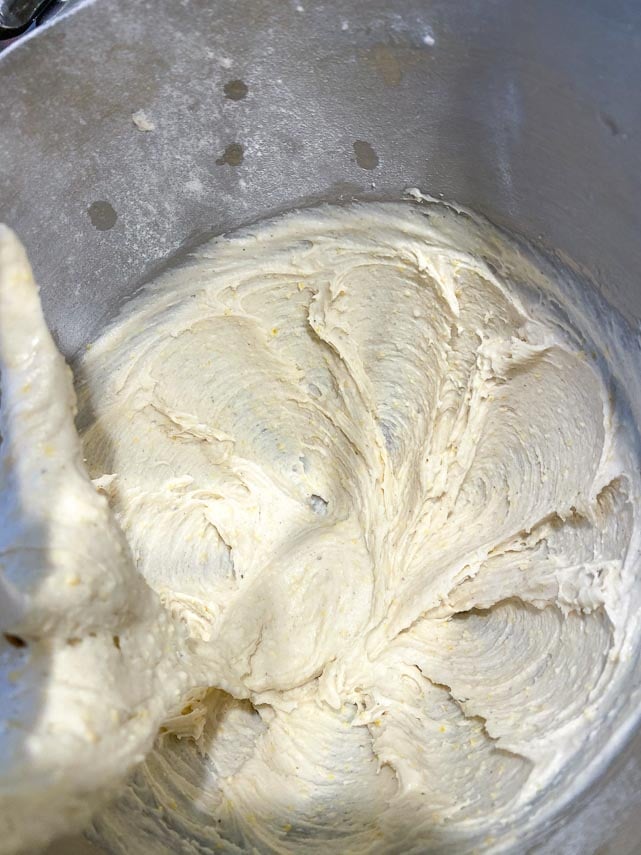
Coat the entire inside of a 9-inch (23 cm) round pan with the remaining 1 tablespoon of butter.
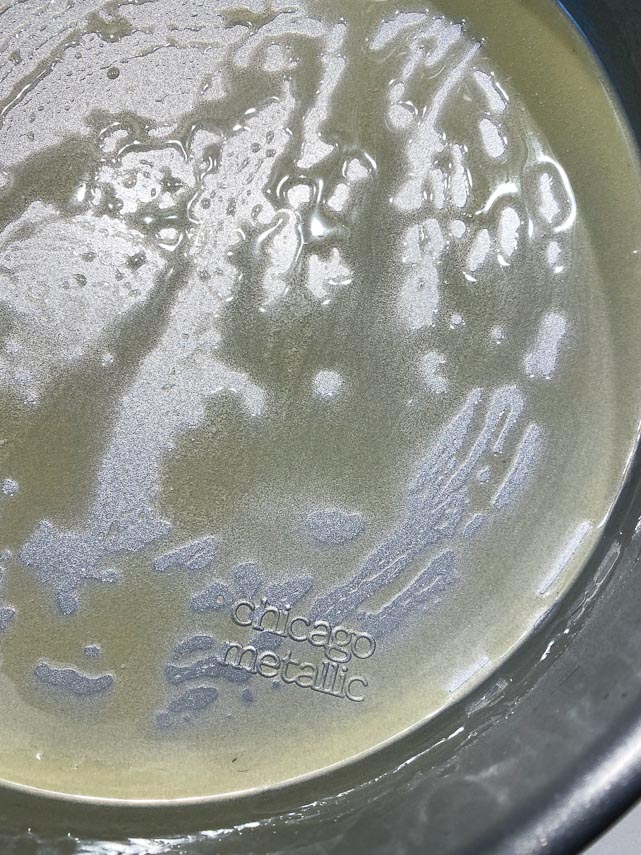
Scrape dough into pan.
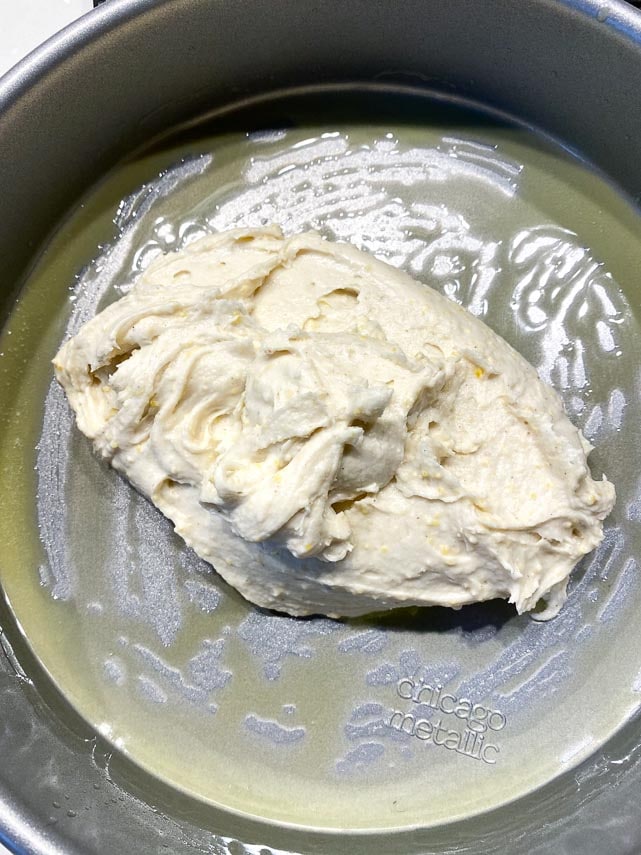
Oil fingers and palms very well and press dough into pan evenly over the bottom and up the sides about 1 ½-inches (4 cm) high.
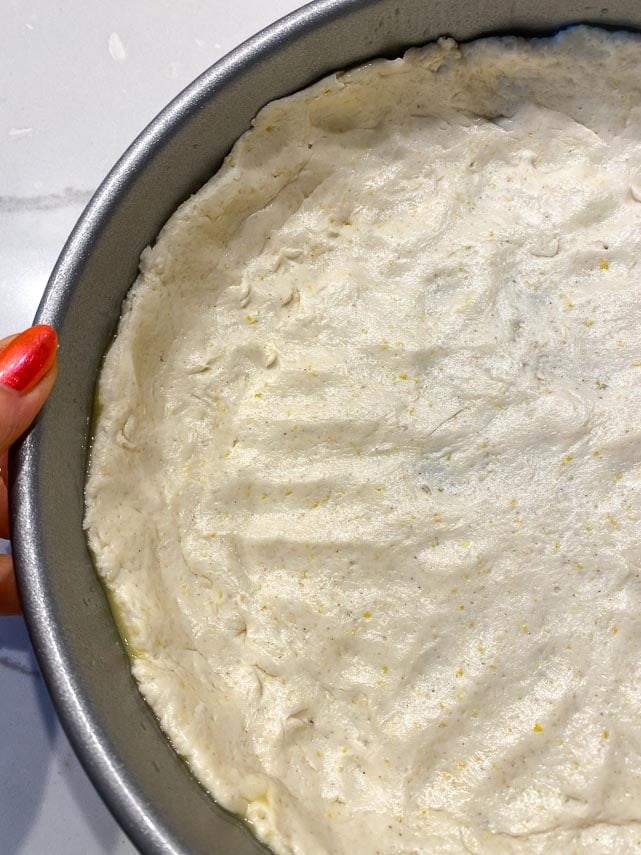
Set aside in a warm, draft-free place to rise for 45 minutes.
Meanwhile, position rack in middle of oven and preheat oven to 425°F (220°C).
Meanwhile, prep your sauce and toppings. Marinara should be room temperature, or at least not cold.
Arrange the sliced Provolone evenly all over the bottom of the pan, over the risen dough.
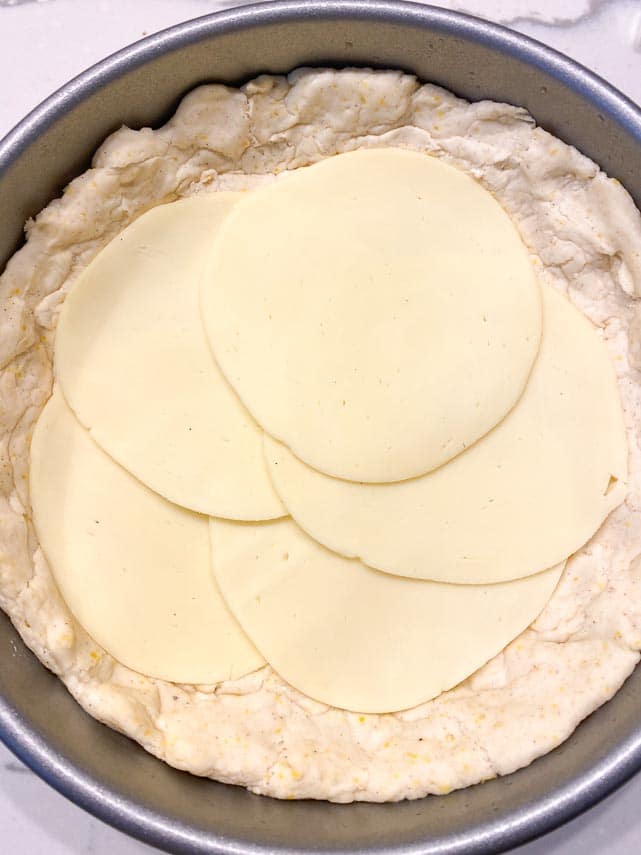
Then scatter the shredded mozzarella over the Provolone.
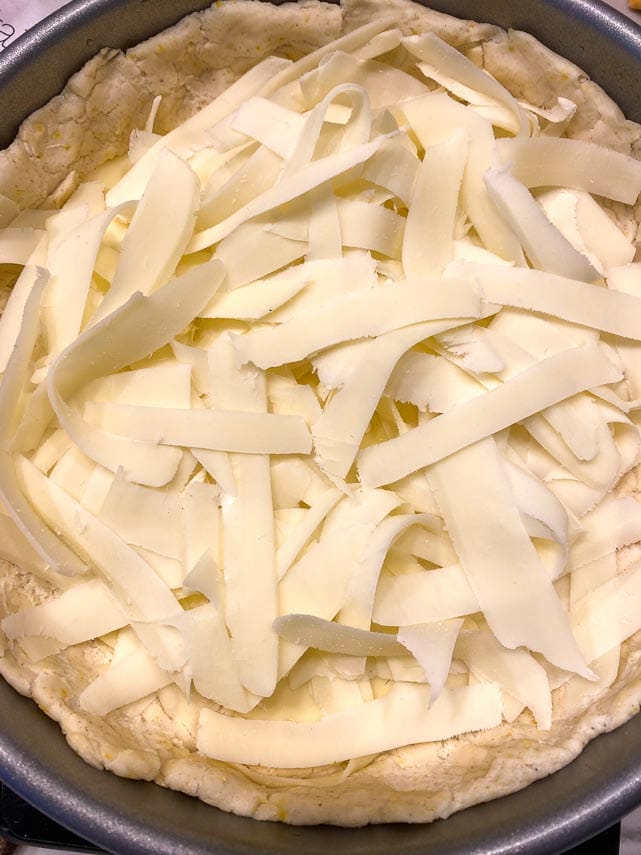
Pinch off small pieces of raw sausage, about the size of small grapes, and scatter those over the cheese. By having the sausage over the cheese all the yummy sausage juices will bathe what is below.
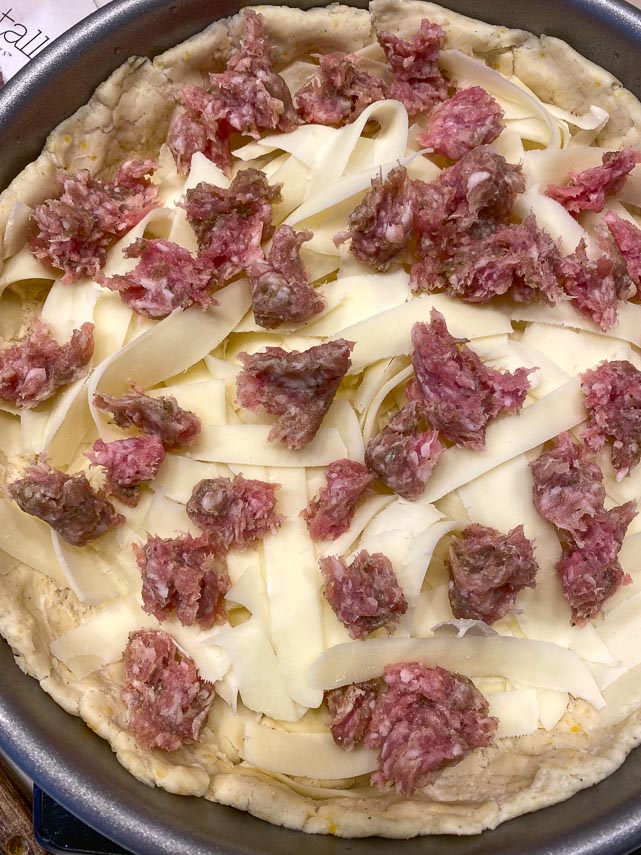
Then dollop the sauce over all and spread gently to cover everything.
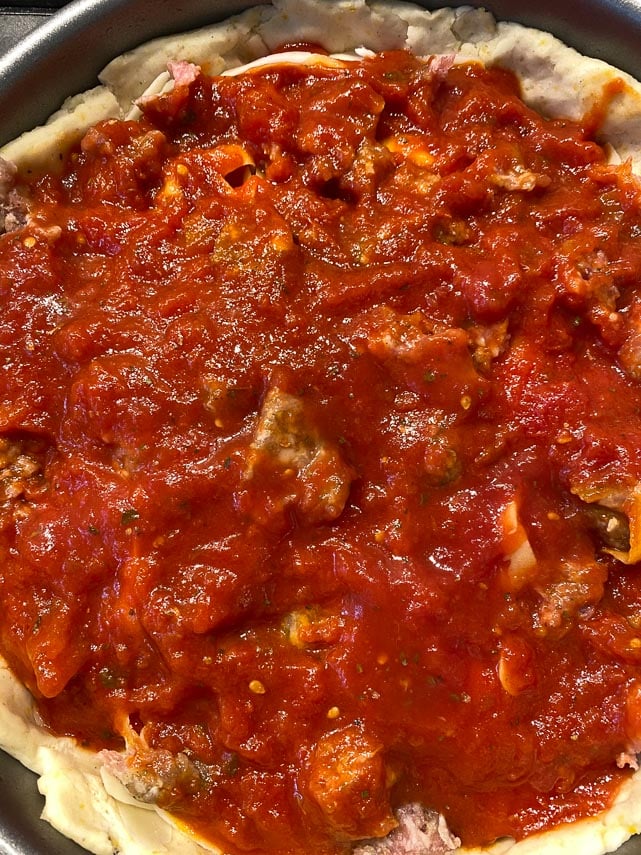
Sprinkle with Parmigiano Reggiano and into the oven it goes.
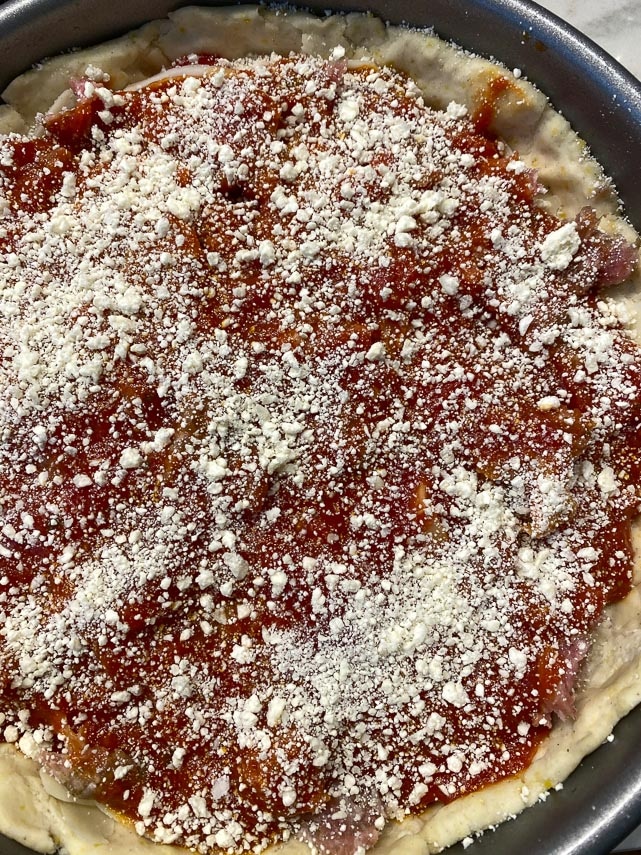
Bake for 35 to 45 minutes or until crust is a rich golden brown and filling is bubbling. Check after 30 minutes and if the pizza is browning too quickly, lightly cover with foil and keep baking.
Remove pan from oven.
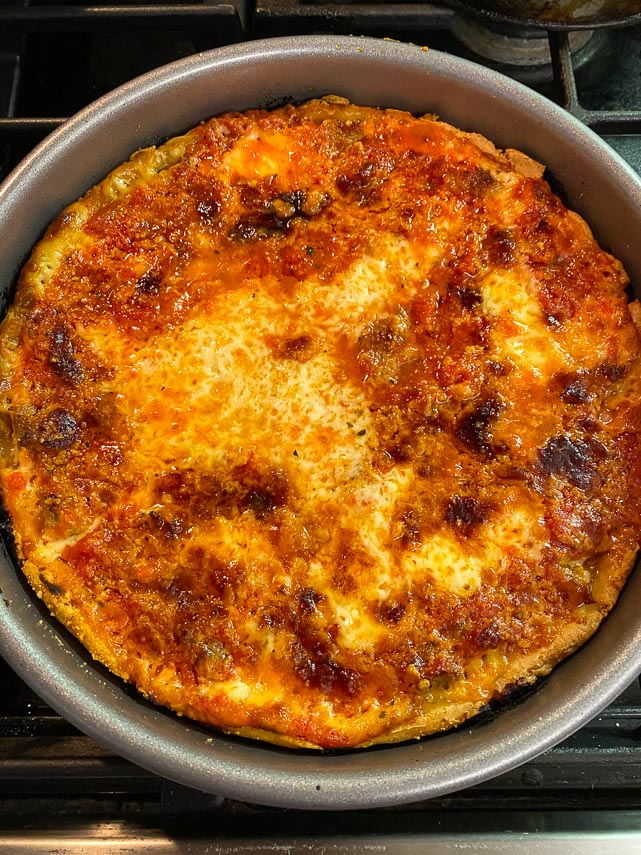
Cool on rack for 5 minutes before cutting into wedges and serving.
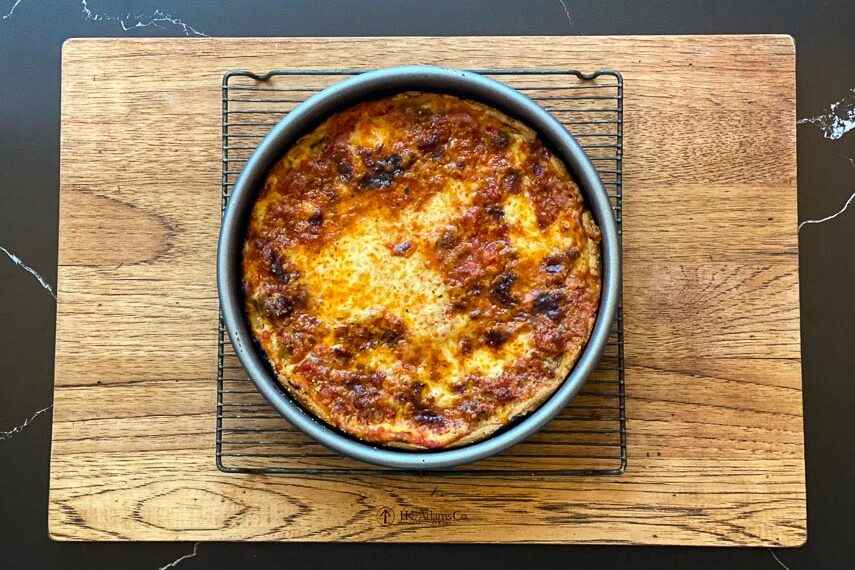
Low FODMAP Deep-Dish Pizza is rich; start with a small serving and assess your tolerance.
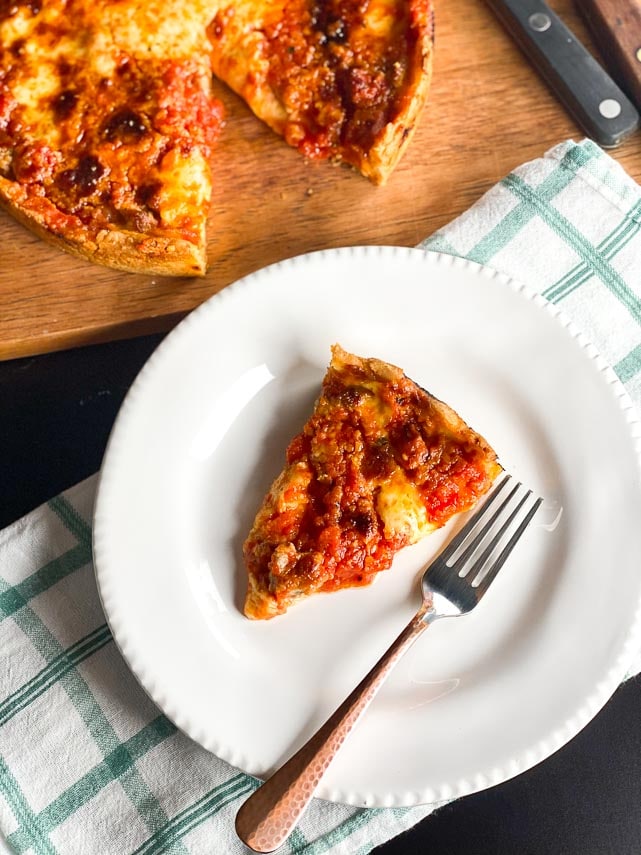
More Gluten-Free Pizza Recipes
Not all of our pizza recipes are gluten-free, but several, in addition to this one, are. Here is our list of Gluten-Free Pizza Recipes.
- Low FODMAP Easy Pizza
- Low FODMAP Pizza 2.0
- Caputo Fioreglut Low FODMAP Pizza
- Low FODMAP Grilled Pizza
- And this one, our Deep-Dish Pizza!
FODMAP Information
Our recipes are based on Monash University and FODMAP Friendly science.
- Canned Tomatoes: Monash University has lab tested canned tomatoes and they are low FODMAP at 92 g or 3.2-ounces, which they say is about ⅗ of a cup. Moderate FODMAPs kick in at about ¾ cup or 115 g, at which point fructose can become an issue.
- Cheese: Many cheeses have low FODMAP serving sizes. The low FODMAP diet is not a dairy-free diet. Hard cheeses such as Parmigiano Reggiano or Pecorino Romano have been lab tested by Monash University and are low FODMAP in 40 g amounts.
- Oil: All pure oils are fats and contain no carbohydrates, therefore they contain no FODMAPs.
- Sugar: Monash University and FODMAP Friendly have both lab tested white, granulated sugar. Monash states that a Green Light low FODMAP serving size of white sugar is ¼ cup (50 g). FODMAP Friendly simply states that they have tested 1 tablespoon and that it is low FODMAP. Regular granulated white sugar is sucrose, which is a disaccharide made up of equal parts glucoseand fructose. Sucrose is broken down and absorbed efficiently in the small intestine.
- Tomatoes: Both Monash University and FODMAP Friendly have lab tested common, beefsteak tomatoes. Monash University lab tests have shown no FODMAPs. FODMAP Friendly gives them a “Pass” at ½ cup (75 g) portions. Cherry tomatoes and Plum (Roma) tomatoes have also been tested by Monash and FODMAP Friendly. Both Monash and FODMAP Friendly recommend 75 g of cherry tomatoes as a serving (about 5 or ½ cup) and 75 g of plum or Roma tomatoes, which is about 1 small tomato or ½ cup.
- Yeast: Yeast – fresh, dry and instant – are all low FODMAP.
Please always refer to the Monash University & FODMAP Friendly smartphone apps for the most up-to-date lab tested information. As always, your tolerance is what counts; please eat accordingly. The ultimate goal of the low FODMAP diet is to eat as broadly as possible, without triggering symptoms, for the healthiest microbiome.
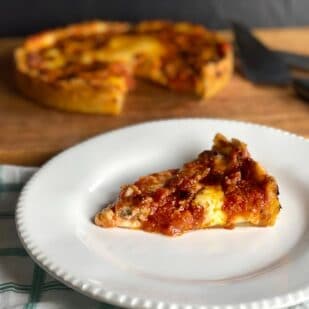
Low FODMAP Deep-Dish Pizza
Low FODMAP Deep-Dish Pizza is possible to create in your very own home oven. What distinguishes this style of pizza is its depth and thickness of crust, abundance of cheese, sauce and fillings, and the fact that many deep-dish pizza dough formulas contain cornmeal as well as butter. You do need a 9-inch (23 cm) deep dish pizza pan.
Ingredients:
Pizza Dough:
- 1 cup (145 g) plus 2 tablespoons low FODMAP gluten-free all-purpose flour, preferably Bob’s Red Mill 1 to 1 Gluten Free Baking Flour
- 1 tablespoon medium ground cornmeal such as Bob’s Red Mill
- 1 ½ teaspoons sugar
- 1 teaspoon salt
- ¾ teaspoon instant dry yeast
- ½ teaspoon xanthan gum
- 2/3 cup (165 ml) warm water, 120°F to 125°F (48°C to 52°C)
- 3 tablespoon melted unsalted butter, slightly warm, divided
- Olive oil
Filling:
- 4- ounces (115 g) thinly sliced Provolone cheese
- 6- ounces (170 g) shredded low-moisture mozzarella
- 4- ounces (115 g) low FODMAP Italian sausage, bulk or casing removed; I used sweet
- 1 1/3 cups (315 ml) low FODMAP marinara sauce such as Rao’s Sensitive Formula Marinara or our Low FODMAP Everyday Quick Tomato Sauce
- 2 tablespoons Parmigiano Reggiano
Preparation:
-
For Making By Hand: Whisk together flour, cornmeal, sugar, salt, instant yeast, and xanthan gum in a large bowl to aerate and combine. Add the warm water and 2 tablespoons melted butter and begin to stir together with a sturdy wooden spoon until a wet dough forms, then beat vigorously until mixture looks like a soft, somewhat wet batter with a little elasticity.
-
For Making With A Stand Mixer: Place flour, cornmeal, sugar, salt, instant yeast, and xanthan gum in stand mixer bowl fitted with flat paddle attachment and mix on low to aerate and combine. Add the warm water and 2 tablespoons melted butter and mix on low-medium speed until a wet dough forms, then turn speed up to medium to medium-high and beat until mixture looks like a soft, somewhat moist dough with a little elasticity.
-
Coat the entire inside of a 9-inch (23 cm) round pan with the remaining 1 tablespoon of butter. Scrape dough into pan, oil fingers and palms very well and press dough into pan evenly over the bottom and up the sides about 1 ½-inches (4 cm) high. Set aside in a warm, draft-free place to rise for 45 minutes.
-
Meanwhile, position rack in middle of oven and preheat oven to 425°F (220°C). Prep your sauce and toppings. Marinara should be room temperature, or at least not cold.
-
Arrange the sliced Provolone evenly all over the bottom of the pan, over the risen dough, then scatter the shredded mozzarella over the Provolone. Pinch off small pieces of raw sausage, about the size of small grapes and scatter those over the cheese, then dollop the sauce over all and spread gently to cover everything. Sprinkle with Parmigiano Reggiano.
-
Bake for 35 to 45 minutes or until crust is a rich golden brown and filling is bubbling. Check after 30 minutes and if the pizza is browning too quickly, lightly cover with foil and keep baking.
-
Remove pan from oven and allow to cool on rack for 5 minutes before cutting into wedges and serving.
Notes:
FODMAP Information
Our recipes are based on Monash University and FODMAP Friendly science.
- Canned Tomatoes: Monash University has lab tested canned tomatoes and they are low FODMAP at 92 g or 3.2-ounces, which they say is about ⅗ of a cup. Moderate FODMAPs kick in at about ¾ cup or 115 g, at which point fructose can become an issue.
- Cheese: Many cheeses have low FODMAP serving sizes. The low FODMAP diet is not a dairy-free diet. Hard cheeses such as Parmigiano Reggiano or Pecorino Romano have been lab tested by Monash University and are low FODMAP in 40 g amounts.
- Garlic-Infused Oil: Make your own Garlic-Infused Oil or buy a commercial equivalent for the easiest way to add garlic flavor to your food. Fructans in garlic are not oil-soluble, so garlic-infused oil is low FODMAP. Oil: All pure oils are fats and contain no carbohydrates, therefore they contain no FODMAPs.
- Sugar: Monash University and FODMAP Friendly have both lab tested white, granulated sugar. Monash states that a Green Light low FODMAP serving size of white sugar is ¼ cup (50 g). FODMAP Friendly simply states that they have tested 1 tablespoon and that it is low FODMAP. Regular granulated white sugar is sucrose, which is a disaccharide made up of equal parts glucose and fructose. Sucrose is broken down and absorbed efficiently in the small intestine.
- Tomatoes: Both Monash University and FODMAP Friendly have lab tested common, beefsteak tomatoes. Monash University lab tests have shown no FODMAPs. FODMAP Friendly gives them a “Pass” at ½ cup (75 g) portions. Cherry tomatoes and Plum (Roma) tomatoes have also been tested by Monash and FODMAP Friendly. Both Monash and FODMAP Friendly recommend 75 g of cherry tomatoes as a serving (about 5 or ½ cup) and 75 g of plum or Roma tomatoes, which is about 1 small tomato or ½ cup.
- Yeast: Yeast – fresh, dry and instant – are all low FODMAP.
Please always refer to the Monash University & FODMAP Friendly smartphone apps for the most up-to-date lab tested information. As always, your tolerance is what counts; please eat accordingly. The ultimate goal of the low FODMAP diet is to eat as broadly as possible, without triggering symptoms, for the healthiest microbiome.
Nutrition
All nutritional information is based on third-party calculations and should be considered estimates. Actual nutritional content will vary with brands used, measuring methods, portion sizes and more. For a more detailed explanation, please read our article Understanding The Nutrition Panel Within Our Recipes.
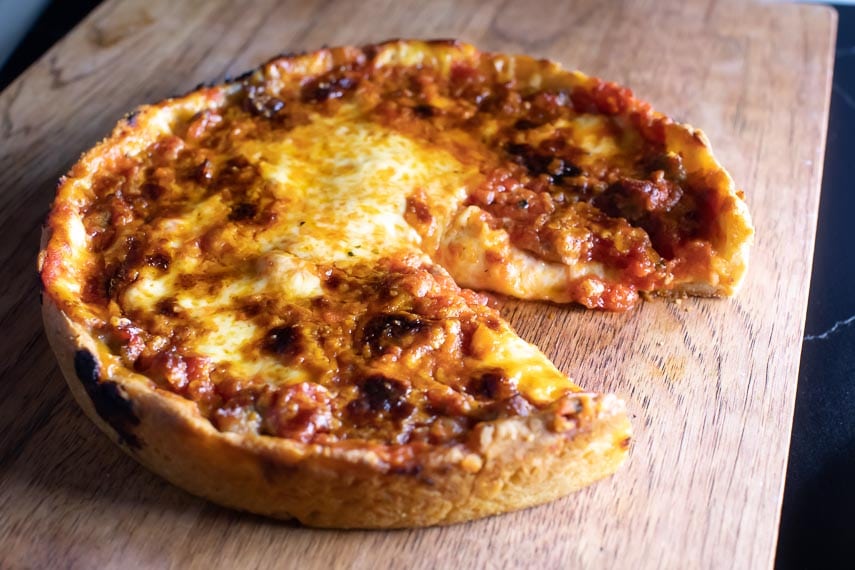
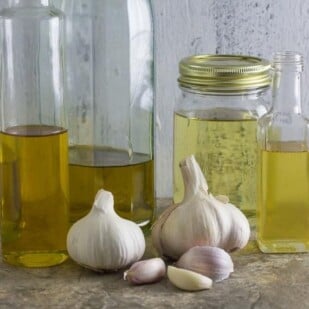







I see you added extra xanthum gum to the recipe even though it’s already I’m the Bob’s 1 to 1 ?
Correct. You need the extra.
WOW!! Hubby is the low fodmapper and very picky. He is raving about this pizza. I don’t have any dietary restrictions but I thought this was amazing as well!! Way better than many local pizza shops. Thank you for all the great recipes!!
Jennifer! You have made my week! Music to my ears. This is so wonderful to hear – it is a mighty tasty pizza! I hope this inspires others to try.
Dede, I hope other try too as they will be so happy they did! I have a question about preparing the crust in advance. Is it possible to prepare it in the pan, and keep it in the fridge till evening or will that destroy the yeast? If we can prepare in advance, do we let it rise fully first before or after fridge time. Thanks!
Hi there! I have not tried myself, but I would pat it into the pan, refrigerate, then pull out and allow to rise. Let us know how it goes! It will essentially be a slow rise.
Sounds good! I’ll let you know what happens…thank you so much!
Only giving 4 stars because the recipe says 1tbsp of the cornmeal but we realized that in the photo, there is a 1/4 cup scooper used for the cornmeal. Thank goodness we saw that! We had spread the dough already in the pan and it was looking way too wet. We scooped it back out and added more cornmeal and got the texture for the dough we were looking for! In the end this was delicious! I’m so excited to have a safe deep dish pizza I can have 🙂
Stephanie, the recipe is correct. It is a wet dough. The image is for looks only, just as we might show a whole cake, but that isn’t serving of cake, or a wedge of lasagna in an image is larger than the serving size. Glad it was delicious though!